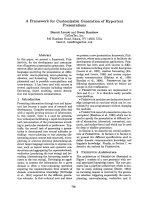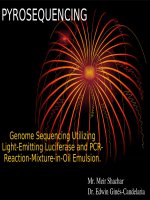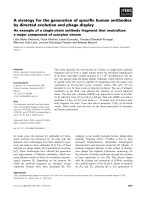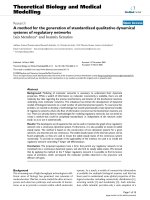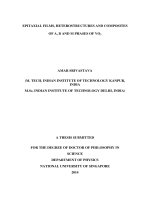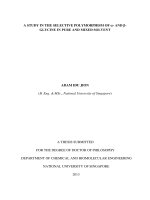Synthetic progress toward parvistemonine, spiroxins a and b, and generation of palmarumycin analogues
Bạn đang xem bản rút gọn của tài liệu. Xem và tải ngay bản đầy đủ của tài liệu tại đây (2.01 MB, 289 trang )
3333
Synthetic Progress Toward Parvistemonine, Spiroxins A and B,
and Generation of Palmarumycin Analogues
by
Erika Elaine Englund
B.S., University of Wisconsin, Madison, 2002
Submitted to the Graduate Faculty of
Arts and Sciences in partial fulfillment
of the requirements for the degree of
Doctor of Philosophy
University of Pittsburgh
2008
ii
UNIVERSITY OF PITTSBURGH
FACULTY OF ARTS AND SCIENCES
This dissertation was presented
by
Erika Elaine Englund
It was defended on
October 7
th
, 2008
and approved by
Dr. Theodore Cohen, Department of Chemistry
Dr. Billy Day, Department of Pharmaceutical Sciences
Dr. Kazunori Koide, Department of Chemistry
Dissertation Director: Dr Peter Wipf, Department of Chemistry
iii
Copyright © by Erika Elaine Englund
2008
iv
Natural products can both challenge synthetic chemists and guide biologists. In this work, they
prompted the extension of oxidative methodology to new systems, inspired the systematic
modification of the palmarumycin scaffold to produce potent thioredoxin/thioredoxin reductase
(Trx/TrxR) inhibitors, and demanded creative synthetic solutions to the structural challenges
Mother Nature provided. The first pursuit was the total synthesis of parvistemonine, a
pentacyclic azacycle isolated from Stemona plants. These plants have been used in Chinese folk
medicine, and the isolated Stemona alkaloids possess therapeutic uses that range from antitussive
to antiparasitic activity. The oxidative cyclization of tyrosine was incorporated into the
syntheses of several natural products, and the extension of this methodology to homotyrosine for
construction of the azacyclic core was investigated. Ultimately, the desired cyclization was not
optimized to give synthetically viable yields, but the competing pathways and preferred
reactivity was elucidated. In a separate project, a library of palmarumycin based prodrugs was
synthesized. The bisnaphthospiroketal functionality, which is present in palmarumycin, is a
lucrative scaffold that potently inhibits thioredoxin/thioredoxin reductase (Trx/TrxR). Some of
the analogues suffered from low solubility, so various amino ester and sugar containing prodrugs
were investigated. A prodrug library with improved solubility and greater plasma stability was
successfully generated. One gram of the lead prodrug was needed for further biological testing,
which would have been challenging with the first generation synthesis. An alternative synthesis
Synthetic Progress Toward Parvistemonine, Spiroxins A and B,
and Generation of Palmarumycin Analogues
Erika Elaine Englund, PhD
University of Pittsburgh, 2008
v
was developed that afforded 1 g of the prodrug and decreased the total number of steps by half
while significantly improving the overall yield. Finally, the total synthesis of spiroxins A and B
was pursued. The spiroxins were isolated from an unidentified marine fungus and only spiroxin
A was tested for biological activity. These highly oxygenated octacyclic compounds only differ
in their degree of chlorination. A synthetic route was proposed that allowed access to both
spiroxin A and B, and only diverged in the final chlorination step. Through a series of
oxidations and reductions, this challenging core was accessed.
vi
TABLE OF CONTENTS
ACKNOWLEDGEMENTS XVII
LIST OF ABBREVIATIONS XIX
1.0 INTRODUCTION TO
THE STEMONA ALKALOIDS 1
1.1 THE STEMONA ALKALOID FAMILY 1
1.2 STEMONA ALKALOIDS’ ISOLATION, STRUCTURE ELUCIDATION
AND SYNTHESES 4
1.3 STEMONA ALKALOID SYNTHESIS IN THE WIPF GROUP 7
1.4 EARLY SYNTHETIC STUDIES TOWARD PARVISTEMONINE 13
2.0 SYNTHETIC APPROACHES TO HOMOTYROSINE 16
2.1 RETROSYNTHETIC ANALYSIS OF HOMOTYROSINE 16
2.2 ALKYNE HYDROALUMINATI
ON AND IMINE SNTHESIS 17
2.3 GRIGNARD ADDITION TO IMINE 63 20
2.4 LITERATURE SYNTHESIS OF HOMOTYROSINE 25
3.0 OXIDATI
ON OF HOMOTYROSINE 27
3.1 OXIDATI
ON OF HOMOTYROSINE TO DIENONE 27
4.0 BIRCH REDUCTION OF HOMOTYROSINE
30
4.1 BIRCH REDUCTION OF HOMOTYROSINE AND ACIDIC
CYCLIZATION 30
vii
4.2 BIRCH REDUCTION OF HOMOTYROSINE AND EPOXIDATI
ON 31
4.3 MODEL STUDIES FOR BIRCH REDUCTION AND EPOXIDE
CYCLIZATION 32
5.0 CONSTRUCTION OF BICYCLIC CORE VIA STETTER REACTION 38
5.1 CATALYSTS FOR STETTER REACTION 38
5.2 STETTER REACTION WITH CYCLOHEXADIENONE 121 43
5.3 STETTER REACTION WITH MODEL SYSTEM
47
6.0 PARVI
STEMONINE CONCLUSIONS 51
7.0 PARVISTEMONINE EXPERIMENTAL PART 53
8.0 BISNAPHTHOSPIROKETALS 78
8.1 INTRODUCTION 78
8.2 BISNAPHTHOSPIROKETAL CLASSIFICATION 79
8.2.1 Type I bisnaphthospiroketals 79
8.2.2 Type II bisnaphthospiroketals 82
8.2.3 Type III bisnaphthospiroketals 84
9.0 THIOREDOXIN/THIOREDOXI
N REDUCTASE 87
9.1 TRX/TRXR BACKGROUND
87
9.2 TRX/TRXR AS THERAPEUTI
C TARGET 89
9.3 EARLY WIPF GROUP WORK WITH TRX/TRXR INHIBITORS 91
9.4 SYNTHESIS OF PALMARUMYCIN PRODRUGS
94
9.4.1 Introduction and history of prodrugs
94
9.4.2 Synthesis of spiroketal 177
96
9.4.3 Generation I prodrugs 102
viii
9.5 SEPARATI
ON OF ENANTIOMERS OF 177 106
9.6 GENERATION II PRODRUGS 108
9.6.1 Amino acid containing prodrugs 108
9.6.2 Carbohydrate linked prodrugs 111
9.6.3 Biological data for generation II prodrugs 116
10.0 SYNTHESIS OF 177 & PRODRUGS EXPERIMENTAL PART 119
11.0 PRODRUG
SCALE-UP 146
11.1 REVISED RETROSYNTHETIC ANALYSIS OF PRODRUG 211
146
11.2 ATTEMPTED SYNTHESIS OF 227 149
11.3 REVISED RETROSYNTHETIC ANALYSIS II 152
11.4 PROTECTING GROUP FREE SYNTHESIS OF BUILDING BLOCKS 153
11.5 SYNTHESIS AND PROTECTION OF NAPHTHOL 238 156
11.5.1 Naphthosultone starting material 156
11.5.2 Acetonide protection of 238 158
11.5.3 Spiroketalization with protected 238 162
11.6 COMPLETION OF THE SYNTHESIS OF 211
163
11.7 PURSUIT OF 211 STARTI
NG FROM 240 170
11.8 CONCLUSION 172
12.0 PRODRUG
SCALE UP EXPERIMENTAL PART 176
13.0 SPIROXIN 197
13.1 SPIROXIN ISOLATION AND CHARACTERIZATION 197
13.2 SPIROXIN BIOSYNTHESIS
AND FIRST RETROSYNTHETIC
ANALYSIS 199
ix
13.3 MODIFIED RE
TROSYNTHETIC ANALYSIS OF SPIROXINS A & B . 201
13.4 SYNTHESIS OF FUNCTIONALIZED BIARYL 284 203
13.4.1 Alternative biaryl synthesis 206
13.4.2 Studies toward the synthesis of the spiroxin core from 284 207
13.4.3 Model system for oxidation of 289 208
13.4.4 Synthesis of spiroxin A core 209
13.4.5 Attempted chlorination of 293
215
13.5 CONCLUSION 217
14.0 SPIROXIN EXPERIMENTAL PART
219
BIBLIOGRAPHY 241
x
LIST OF TABLES
Table 2.1. Hydroalumination of phenylacetylene conditions
19
Table 2.2. Grignard conditions for addition into imine 63 24
Table 3.1. Oxidative cyclization of homotyrosine conditions 29
Table 4.1. Acidic and basic conditions explored for cyclization to 96 36
Table 5.1. Oxidation conditions to aldehyde 123 44
Table 5.2. Cyclization conditions of cyclohexadienone 121 46
Table 9.1. IC
50
(μM) values for Trx-1/TrxR inhibition and cell growth inhibition 94
Table 9.2. Oxidative cyclization of 193 101
Table 9.3. IC
50
values (μM) for TrxR and human breast cancer growth inhibition 105
Table 9.4. Relative plasma stabilities of prodrugs (in area/20 min) 117
Table 9.5. Water solubility of prodrugs 118
Table 11.1. Deprotection conditions of naphthosultone 246 158
Table 11.2. Conditions explored for deprotection
of 249 160
Table 11.3. Spiroketalization to 258 conditions 165
Table 11.4. Benzylic oxidation optimization for conversion of
258 to 259 166
Table 11.5. Optimization of oxidation of 259 to enone 260 167
Table 11.6. Deprotection conditions of 260 to 177 169
xi
LIST OF FIGURES
Figure 1.1. Structure of parvistemonine (1) 1
Figure 1.2. Structure of a recently isolated Stem
ona alkaloid, stemocurtisine (2) 3
Figure 1.3. Five groups of Stemona alkaloids 4
Figure 1.4. First isolated Stemona alkaloid, tuberostemonine (3) 5
Figure 1.5. Proposed transition states in oxidative cyclization of tyrosine 9
Figure 1.6. Structures of aranorosin (21) and aeruginosin 298-A (22) 10
Figure 1.7. Structures of Stemona alkaloid synthetic targets in the Wipf group 11
Figure 2.1. Proposed conformation of BF
3
complexed 63 21
Figure 5.1. Benzoin condensation mechanism 39
Figure 5.2. Triazolium salts utilized by Rovis group for Stetter reaction 40
Figure 5.3. Catalysts investigated f
or Stetter reaction 40
Figure 5.4. Target substrate for Stetter reaction
43
Figure 5.5. Proposed base-induced fragm
entation of cyclohexadienone 121 47
Figure 5.6. Major product isolated from Stetter reaction, 138 49
Figure 8.1. Palmarumycin (139) and spiroxin B (140) 79
Figure 8.2. Palmarumycins CP
1
-CP
4
(139, 141-143) 80
Figure 8.3. Palmarumycin CP
1
(139), C
2
(144) and diepoxin σ (145) 81
xii
Figure 8.4. Preussomerin A (151), preussom
erin C (152) and preussomerin H (153) 83
Figure 8.5. Interconversion between 154 and 155 84
Figure 8.6. Type III bisnaphthospiroketals 85
Figure 9.1. Trx/TrxR redox cycle 88
Figure 9.2. Crystal structure of hTrx hom
odimer
150
89
Figure 9.3. Trx/TrxR inhibitors 90
Figure 9.4. Pleurotin, a potent Trx/T
rxR inhibitor 92
Figure 9.5. Early palmarumycin analogues 93
Figure 9.6. Commercially available prodrugs 96
Figure 9.7. PIFA mediated oxidative cyclization of 193
245
100
Figure 9.8. Oxidation side product, juglone (198) 101
Figure 9.9. Sugar based cancer inhibitor 112
Figure 13.1. Spiroxins 197
Figure 13.2. Terreic acid (264) and frenolicin (265) 198
Figure 13.3. HMBC (left) and NOE (right) analyses of spiroxin A (156)
126
199
Figure 13.4. Stereoviews of 271 (top) and epi-271 (bottom
) 214
Figure 13.5. Model of spiroxin core 293 215
xiii
LIST OF SCHEMES
Scheme 1.1. Williams’ retrosynthetic analysis of (±) croomine (4) 6
Scheme 1.2. Chen and Hart’s retrosynthetic analysis of stenine (9) 7
Scheme 1.3. Oxidative cyclization of tyrosine (16) 8
Scheme 1.4. Total synthesis of tuberostemonine (3) 12
Scheme 1.5. Retrosynthetic analysis of parvistemonine (1) 13
Scheme 1.6. Synthesis of parvistemonine model 51 14
Scheme 2.1. Homotyrosine retrosynthetic analysis
16
Scheme 2.2. Prior Wipf group work with imine additions 17
Scheme 2.3. Imine 61 formation from ethyl glyoxylate (56) 18
Scheme 2.4. Addition of hydroaluminated phenylacetylene to tosylimine 61 19
Scheme 2.5. Grignard addition to imine 63 20
Scheme 2.6. Ellman’s synthesis of sulfinamide 68 21
Scheme 2.7. Chiral auxiliary mediated enantioselective synthesis of sulfonam
ide 68 22
Scheme 2.8. Grignard addition into sulfonyl imine 63 23
Scheme 2.9. Literature synthesis of hom
otyrosine (79) 25
Scheme 3.1. Oxidative cyclization of homotyrosine 28
Scheme 4.1. Bonjoch’s synthesis of L-Choi (85) 30
xiv
Scheme 4.2. Reduction and cyclization of hom
otyrosine 31
Scheme 4.3. Bisepoxidation of diene 86 32
Scheme 4.4. Preparation of diene model system 91 33
Scheme 4.5. Bisepoxidation of 91 33
Scheme 4.6. Danishefsky’s conditions for glycal epoxidation
34
Scheme 4.7. Epoxidation and acetal formation 35
Scheme 4.8. Intramolecular epoxide opening of 95 36
Scheme 5.1. Aliphatic Michael acceptors in Stetter reaction
41
Scheme 5.2. Synthesis of Stetter catalyst 108 42
Scheme 5.3. Model system oxidation 43
Scheme 5.4. Aldehyde 121 synthesis 44
Scheme 5.5. Stetter reaction with dieneone 121 45
Scheme 5.6. Synthesis of chain extended aldehyde 136 48
Scheme 5.7. Stetter reaction analogue 49
Scheme 8.1. Taylor's acid catalyzed spiroketalization 82
Scheme 8.2. Oxidative cyclization to spiroketal 150 82
Scheme 8.3. Imanishi's spiroxin C (157) synthesis 86
Scheme 9.1. Synthesis of naphthyl fluoride 186 97
Scheme 9.2. Synthesis of naphthaldehyde 191 98
Scheme 9.3. Synthesis of palmarumycin analogue 177 99
Scheme 9.4. Synthesis of 177 prodrugs
103
Scheme 9.5. Mono and bis-acetylated 177 107
Scheme 9.6. BOC-protection of AIB (208) and phenylalanine (206) 110
xv
Scheme 9.7. Prodrugs containing am
ino acids 207 and 209 111
Scheme 9.8. Synthesis of C-glycoside 213 112
Scheme 9.9. Proposed path to C-glycosylated 177 113
Scheme 9.10. Glycosylation of 177 114
Scheme 9.11. Synthesis of acetylated imidate 223 115
Scheme 9.12. Glycosylation of 177 and deprotection 116
Scheme 11.1. Modified retrosynthetic analysis of 211 148
Scheme 11.2. Failed synthesis of 226 149
Scheme 11.3. Modified retrosynthetic analysis of 227 150
Scheme 11.4. Synthesis of acetate 229 150
Scheme 11.5. Selective monoketalization 151
Scheme 11.6. Conjugate addition of naphthol 229 to 228 152
Scheme 11.7. Revised retrosynthetic analysis II 153
Scheme 11.8. Attempted protecting group free spiroketalization 154
Scheme 11.9. Spiroketalization with enol ether 242 155
Scheme 11.10. Morpholine and pyrrolidine enam
ines of tetralone 146 156
Scheme 11.11. Synthesis of 229 from naphthosultone 245 157
Scheme 11.12. Attempted naphthosultone conversion to 247 157
Scheme 11.13. Planned synthesis of 229 via the aceton
ide 159
Scheme 11.14. Protection of naphthalene triol 238 159
Scheme 11.15. Failed protection of 238 with benzophenone acetal
161
Scheme 11.16. Failed protection of 238 with bridging silane
161
Scheme 11.17. Acetate protected naphthol 229 in spiroketalization 162
xvi
Scheme 11.18. Silylation and debenzylation of naphthoquinone 230 163
Scheme 11.19. Spiroketalization and enone formation 164
Scheme 11.20. Methyl ether deprotection and desilylation
169
Scheme 11.21. Synthesis of AIB prodrug 211 170
Scheme 11.22. Spiroketalization with free phenol 261 171
Scheme 11.23. Undesired oxidation of spiroketal to 263 172
Scheme 11.24. Original synthesis of 177 173
Scheme 11.25. Final route for scaleup of 177 174
Scheme 13.1. Original retrosynthetic analysis of spiroxin (140) 200
Scheme 13.2. Updated retrosynthetic analysis of spiroxins A (156) and B (140) 202
Scheme 13.3. Synthesis of bromonaphthalene 278 203
Scheme 13.4. Synthesis of 273 by biaryl coupling 204
Scheme 13.5. Spiroxin core functionalization 206
Scheme 13.6. Alternative biaryl synthesis via homocoupling of 285 207
Scheme 13.7. Oxidation of 289 208
Scheme 13.8. CAN oxidation of model system 188 209
Scheme 13.9. Acetate deprotection of 290 210
Scheme 13.10. Proposed intermediates enroute to 271 211
Scheme 13.11. Mechanistic pathway for formation of 271 212
Scheme 13.12. Epoxidation conditions of 271 213
Scheme 13.13. Failed chlorination of 293 216
Scheme 13.14. Attempted synthesis of 140 218
xvii
ACKNOWLEDGEMENTS
I would like
to first thank my advisor, Dr. Wipf and the members of my committee: Dr. Cohen,
Dr. Day and Dr. Koide. I would also like to thank the members of the Wipf group, both past and
present. Dr. Stephen Lynch and Dr. David Mareska contributed to the groundwork of the
bisnaphthospiroketal and parvistemonine projects, respectively. There are many individuals
from over the years who I will never be able to thank enough. Dr. Cody Timmons and Dr.
Stephan Elzner could be consulted on almost any issue and reliably provided both insights and
laughter. Working with them, in combination with Julia Vargas, resulted in some of the best
discussions and days in lab. I want to thank my I.T. support of Chenbo Wang and Dr. Kevin
Davies. Although this was not their official title, they expertly diagnosed my paralyzed
computer more times than I can count. I want to thank Dr. Zhenkun Ma, Dr. Robert Keyes and
Alan Flojancic from Abbott. Their discussions, guidance and support have been a source of
unrivaled mentorship. I also want to thank friends and family outside this department who have
helped me stay grounded and been a source of unwavering support over the years. In particular,
I want to thank my cousins Alanna and Camilla Mingay. I think that I found the best travel
companions ever and am already looking forward to our next destination, wherever that might
be. Last, but certainly not least, I need to thank Zeeshan Ahmed. He is able to inspire,
challenge, support and push all at once while making the light at the end of the tunnel seem not
xviii
so far away. I can not imagine what my time in Pittsburgh would have been like without him. In
all honesty, there is nothing more that I could ask for.
xix
LIST OF ABBREVIATIONS
Ac………………… acyl
Acac…………………acetylacetonate
AIB………………….α-am
inoisobutyric acid
AIBN……………… 2,2’-azobis(2-methylpropionitrile)
ATR…………………Attenuated total reflection
BCNU………………1,3-bis(2-chloroethyl)-1-nitrosourea
B-I-9-BBN………….9-iodo-9-borabicyclo[3.3.1]nonane
Bn………………… benzyl
Boc………………….tert-butyloxycarbonyl
Bu………………… butyl
CAN……………… ceric ammonium nitrate
CD………………… circular dichroism
CDI………………….carbonyl diimidazole
Choi…………………2-carboxy-6-hydroxyoctahydroindole
d…………………….day
Dba………………….dibenzylideneacetone
DBB…………………4,4-di-tert-butylbiphenyl
DBU……… 1,8-diazabicyclo[5.4.0]undec-7-ene
DCC 1,3-dicyclohexylcarbodiimide
DDQ dichlorodicyanoquinone
DEAD………………diethylazodicarboxylate
DIAD diisopropylazodicarboxylate
DIBALH diisobutylaluminum hydride
DMAP 4-(dimethylamino)pyridine
xx
DMDO dimethyldioxirane
DMF dimethylformamide
DMP Dess-Martin periodane
DMSO dimethylsulfoxide
DTNB……………….dithionitrobenzoic acid
ee enantiomeric excess
equiv.……………….equivalent
Et ethyl
FAD……………… flavin adenine dinucleotide
GI
50
…………………half of growth inhibition
h…………………… hour
HMPA hexamethylphosphoramide
IC
50
…………………half of inhibitory concentration
Im………………… imidazole
LAH lithium aluminum hydride
LC
50
median lethal concentration
LDA lithium diisopropylamide
LHMDS lithium hexamethyldisilazane
mCPBA meta-chloroperoxybenzoic acid
Me methyl
min minute
MOM methoxymethyl ether
MTT……………… 3-[4,5]-dimethylthiazol-2-yl-2,5-diphenyltetrazolium bromide
NADPH…………….nicotinamide adenine dinucleotide phosphate
N-BCC N-benzyl cinchonidinium chloride
NBS N-bromosuccinimide
NCS N-chlorosuccinimide
NMO 4-methylmorpholine N-oxide
NMR nuclear magnetic resonance
n.r………………… no reaction
PCC pyridinium chlorochromate
xxi
PDC pyridinium dichromate
Ph phenyl
PIDA iodobenzene diacetate
PIFA [bis(trifluoroacetoxy)iodo]benzene
Piv……………… pivaloyl
PPA polyphosphoric acid
PPTS pyridinium para-toluenesulfonate
r.t……………………room temperature
TBAF tetrabutylammonium fluoride
TBHP tert-butyl hydrogen peroxide
TBSCl tert-butyldimethylsilyl chloride
TCE tetrachloroethane
TESOTf…………….triethylsilyl trifluoromethane sulfonate
TFA trifluoroacetic acid
TFAA trifluoroacetic anhydride
TFE………………….trifluoroethanol
THF…………………tetrahydrofuran
TIBA triisobutylaluminum
TMSOTf…………….trimethylsilyl trifluoromethanesulfonate
Tos para-toluene sulfonate
TPAP……………….tetra-n-propylammonium perruthenate
Trx/TrxR……………thioredoxin/thioredoxin reductase
Ts……………………para-toluene sulfonyl
1
1.0 INTRODUCTION TO THE STE
MONA ALKALOIDS
1.1 THE STEMONA ALKALOID FAMILY
Parvistemonine (1, Figure 1.1) is a member of the Stemona class of alkaloids. The structural
features of two lactones, a 4-azaazulene ring and ten stereocenters pose interesting synthetic
challenges in a relatively compact arrangement. This structural complexity, along with the
diverse biological activity found among members of this class of natural products, has prompted
synthetic interest in this compound. Diels-Alder reactions,
1
oxidative cyclization
2,3
and the
Staudinger
4
reaction have all been explored in efforts to construct the 4-azaazulene ring system.
At this time, there have been no other reports of partial or total synthetic approaches to
parvistemonine outside of those from the Wipf group.
Figure 1.1. Structure of parvistemonine (1)
The source of Stemona alkaloids are the Stemona plants, also known as Roxburghia.
They are found in South Asia, Malaysia and North Australia and are classified as subshrubs, or
2
twining herbs, with thick and tuberous roots.
5
This family can be divided into three genera:
Stemona, Croomia, and Stichoneuron. The Stemona genera, which contains parvistemonine, is
the largest of the three groups and contains more than 25 species.
6
This family of plants has a
history of medicinal applications.
Stemona and Croomia plants are used in both Japanese and Chinese folk medicine to treat
an array of medical conditions. The roots are boiled in water and the extracts consumed to treat
illnesses as diverse as pulmonary bronchitis, tuberculosis and intestinal parasites.
5
The roots of
the Stemona plants are still sold for their medicinal properties. On the internet, these roots are
being advertised for conditions as varied as head lice, scabies, colds, and pulmonary
tuberculosis.
7
These traditional applications prompted further investigation into the source of
this biological activity.
There have been several reports exploring the details of the biological activities of the
various components of the Stemona plants. Many biological studies have focused on the roots,
but there have also been studies on the leaf and rhizome extracts along with individually isolated
alkaloids.
8,9
Tuberostemonine, stemofoline, didehydrostemofoline and other Stemona alkaloids
all show insecticidal activity against larvae.
10
In another study, tuberostemonine was shown to
act as a glutamate inhibitor at the neuromuscular junction of crayfish with a potency that matches
clinically proven glutamate inhibitors.
11
Neostenine and neotuberostemonine both show
antitussive activity in guinea pigs.
12
3
Figure 1.2. Structure of a recently isolated Stemona alkaloid, stemocurtisine (2)
Stemona alkaloids have some common structural features. Their most distinct component
is the 1-azabicyclo[5.3.0]-decane, or 4-azaazulene, ring system. An exception to this
generalization was reported in 2003. Stemocurtisine (2, Figure 1.2) contains the [1,2-a]azepine
core
13
and exhibits larvicidal activity.
14
Excluding the structural variability in some of the most
recently isolated members, there have been several proposed ways to further subdivide this class.
One proposal classifies the Stemona alkaloids into five groups, each named after a representative
member: stenine, stemoamide, tuberostemospironine, stemonamine and parvistemoline (Figure
1.3).
5
These groups predominantly distinguish themselves from one another by the presence and
arrangement of the lactone and furan moieties.
4
N
O
O
N
O
N
O
O
N
O
O
O
N
O
O
O
Stenine Core Stemoamide Core Tuberostemospironine Core
Stemonamine Core
Parvistemoline Core
Figure 1.3. Five groups of Stemona alkaloids
1.2 STEMONA ALKALOIDS’ ISOLATION, STRUCTURE ELUCIDATION AND
SYNTHESES
The scientific community was first introduced to the family of Stemona alkaloids with the
isolation of tuberostemonine (3, Figure 1.4) in 1934.
15
However, its structure was not elucidated
until 1968 by
1
H NMR, mass spectrometry, X-ray studies, UV, IR and degradation studies.
16
Throughout the 1980s, Ren-Sheng Xu led an extensive investigation into the structure
determination and isolation of new Stemona alkaloids. Through the collective work of him and
others, about 42 Stemona alkaloids have been described.
5
In 1990, Ren-Sheng Xu and
coworkers published the isolation and characterization of parvistemonine. The structure was
elucidated by
1
H and
13
C NMR, MS, COSY, NOESY, IR and various two dimensional
techniques.
17

